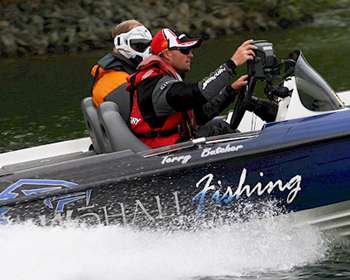
Bass fish long enough, and you'll undoubtedly come across this scenario: As the summer heat gives way to cooler fall temperatures, you hook up the boat and head to a nearby lake planning on flipping shallow cover for aggressive bass.
The problem is, as you pull up the ramp you realize that the water has dropped and the shallow cover you were planning on fishing is now high and dry. "This happens a lot in the fall and I used to think that it was going to be impossible to catch any bass," admits Elite Series pro Terry Butcher. "When the water drops, there are miles of water and it all looks the same."
Over the course of his career, the Oklahoman has realized that an unexpected drop in water simply requires an adjustment in the day's approach and game plan. With some common sense and an optimistic attitude, a great day on the water is still within reach.
Butcher says that just because the obvious cover like willow trees, laydowns and shallow stumps are above the water line, it doesn't mean that the bass have vacated the general vicinity. "Those fish are still there," he says. "Chances are they just moved a little."
He begins his search for bass by locating the nearest structure that is in the water adjacent to where the bass were positioned before the water dropped. Often, it's a small break, dropoff or channel bend. "It may only be 3 feet deep for 100 yards in front of the cover, but there's going to eventually be a small break where it may dip from 3 to 6 feet.
That's an area that I'm going to key on," Butcher says. Even though he's targeting relatively shallow water, Butcher says that quality electronics play an important part in locating key structure and bottom composition where the bass will position after the water drops. "I'll spend time idling across obvious points looking for structure and brushpiles.
If I can get a few bites, it's a lot easier to expand and define a productive area." Aside from keying on shallow breaks and brushpiles in front of shoreline cover, Butcher stresses the importance of not overlooking isolated cover that is now visible due to the drop in the water level. If he's running down a bare bank and sees a submerged log or bush, he will stop and fish it. "That type of cover is usually good for at least one fish.
If you find the right one, you'll catch several off of it," Butcher says. "Just because most of the cover is out of the water doesn't mean that you can't still fish shallow." While an unexpected drop in water level is an obstacle that can be overcome, Butcher points out that, with a little homework, the situation can be totally avoided. "It doesn't take any time at all to get on the Internet and find out what the water level is," he says. "It will allow you to develop a strategy before you get to the lake."
(Provided by Z3 Media)




